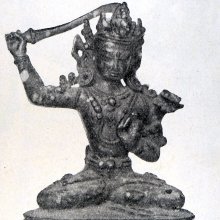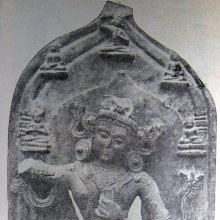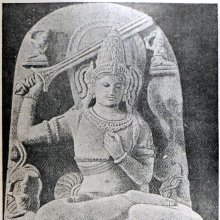Arapacana: 7 definitions
Introduction:
Arapacana means something in Buddhism, Pali, Hinduism, Sanskrit. If you want to know the exact meaning, history, etymology or English translation of this term then check out the descriptions on this page. Add your comment or reference to a book if you want to contribute to this summary article.
Alternative spellings of this word include Arapachana.
Images (photo gallery)
In Buddhism
Mahayana (major branch of Buddhism)
Source: Wisdom Library: Maha Prajnaparamita SastraArapacana (अरपचन) is the name of an alphabet, as mentioned in the Mahāprajñāpāramitāśāstra chapter XLIII.—Dhāraṇī based on the Arapacana alphabet of which the forty-two letters are supposed to represent all the phonemes of the spoken language. It notes some sounds that are not of Indian origin but belong rightly to Iranian languages; it was a matter of a Scythian alphabet introduced into India by the Śaka about the time of the Christian era (cf. Mémorial Sylvain Lévi, Ysa, Paris, p. 355–363).
In the Avataṃsaka, a young scholar named Viśvāmitra informs Sudhana that by pronouncing the phonemes listed in the Arapacana alphabet, he broke through each of the forty-two gates (mukha) of the Prajñāpāramitā in turn. See the section of the Gaṇdavyūha, ed. Suzuki and the various Chinese translations, complete or partial. The Arapacana formula was called on to play an important part in the cabbala of Tantric Buddhism. On this subject, see Hōbōgirin, s.v. Arahashana, p. 34; Ceylon Encyclopedia, II, p. 67–70.

Mahayana (महायान, mahāyāna) is a major branch of Buddhism focusing on the path of a Bodhisattva (spiritual aspirants/ enlightened beings). Extant literature is vast and primarely composed in the Sanskrit language. There are many sūtras of which some of the earliest are the various Prajñāpāramitā sūtras.
Tibetan Buddhism (Vajrayana or tantric Buddhism)
Source: archive.org: The Indian Buddhist IconographyArapacana (अरपचन) refers to one of the various forms of Mañjuśrī having their Sādhana described in the 5th-century Sādhanamālā (a collection of sādhana texts that contain detailed instructions for rituals).—His Colour is white or red; his Āsana is the vajraparyaṅka; his Symbols are the book and the sword; he has four companions.—Arapacana is accompanied by the four divinities, Keśinī, Upakeśinī, Candraprabha and Sūryaprabha, and as the group of five originates from the five syllables, ‘A’, ‘R’, ‘P’, ‘C’ and ‘N’, the principal god is called Arapacana. When represented, the four companions of Arapacana resemble the principal god in all respects.
Arapacana is also called Sadyonubhava-Arapacana, or Sadyonubhava-Mañjuśrī.—He is resplendent like the full moon, has a smiling face, is decked in all sorts of princely ornaments, and sits on a double lotus in the Vajraparyaṅka attitude. He brandishes the sword in his right hand, while his left holds the Prajñāpāramitā book against his chest. Jālinīkumāra (or Sūryaprabha) is in front of him, Candraprabha behind, Keśinī to the right and Upakeśinī to the left. All these four divinities are replicas of the principal god.
The Dhyāna (meditation instructions) of Arapacana is described in the Sādhanamālā as follows:
“The worshipper should think himself as Sadyonubhava-Arapecana,who carries the Khaḍga and the book, and wears the five cīrakas (rags) which are slightly folded. His garments are of red colour, which befits the Śṛṅgāra-rasa he displays. His face is radiant with a smile, and is resplendent like the moon. He sits on a double lotus in the vajraparyaṅka attitude...”.
[This Sādhana further adds that the principal god should originatefrom the first syllable “A”, Jālinīkumāra from the syllable “R”, Candraprabha from “P”, Keśinī from “C” and Upakeśinī from “N”. Mañjuśrī should be in the middle, Jālinīkumāra in front, Candraprabha behind, Keśinī to the right and Upakeśinī to the left. All of them should have white colour and should be identical with the principal god in appearance. ]

Tibetan Buddhism includes schools such as Nyingma, Kadampa, Kagyu and Gelug. Their primary canon of literature is divided in two broad categories: The Kangyur, which consists of Buddha’s words, and the Tengyur, which includes commentaries from various sources. Esotericism and tantra techniques (vajrayāna) are collected indepently.
Languages of India and abroad
Sanskrit dictionary
Source: DDSA: The practical Sanskrit-English dictionaryArapacana (अरपचन).—A mystical collective name of the 5 Buddhas.
Derivable forms: arapacanaḥ (अरपचनः).
Source: Cologne Digital Sanskrit Dictionaries: Edgerton Buddhist Hybrid Sanskrit DictionaryArapacana (अरपचन).—a name of Mañjuśrī: Sādhanamālā 94.15 et alibi.
Source: Cologne Digital Sanskrit Dictionaries: Monier-Williams Sanskrit-English DictionaryArapacana (अरपचन):—m. a mystical collective Name of the five Buddhas (each being represented by a letter).
[Sanskrit to German]
Sanskrit, also spelled संस्कृतम् (saṃskṛtam), is an ancient language of India commonly seen as the grandmother of the Indo-European language family (even English!). Closely allied with Prakrit and Pali, Sanskrit is more exhaustive in both grammar and terms and has the most extensive collection of literature in the world, greatly surpassing its sister-languages Greek and Latin.
See also (Relevant definitions)
Ends with: Aharapacana, Badarapacana, Karparapacana.
Full-text: Sadyonubhava, Suryaprabha, Upakeshini, Kesini, Sudhanakumara, Siddhaikavira, Manjushri, Yamari, Jaliniprabha, Candraprabha.
Relevant text
Search found 3 books and stories containing Arapacana; (plurals include: Arapacanas). You can also click to the full overview containing English textual excerpts. Below are direct links for the most relevant articles:
The Indian Buddhist Iconography (by Benoytosh Bhattachacharyya)
Maha Prajnaparamita Sastra (by Gelongma Karma Migme Chödrön)
Appendix 3 - The forty-two letters of the Arapacana alphabet < [Chapter XLIII - The Pursuit of the Six superknowledges]
I. Gates of remembrance (dhāraṇi-mukha) < [Part 4 - Obtaining the gates of recollection and concentration]
Introduction to fourth volume < [Introductions]
A Dictionary Of Chinese Buddhist Terms (by William Edward Soothill)



